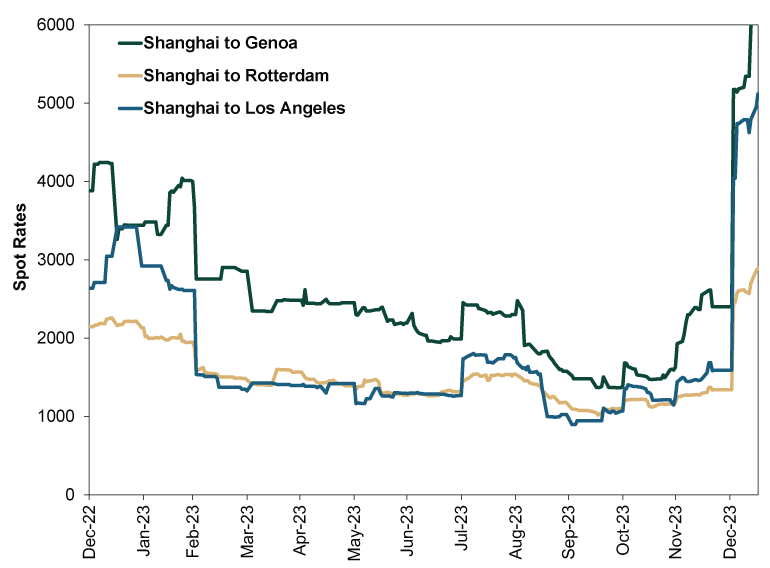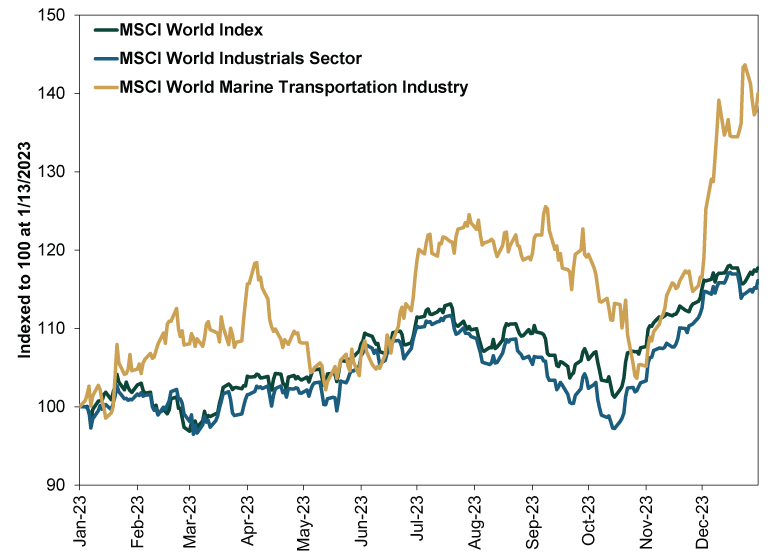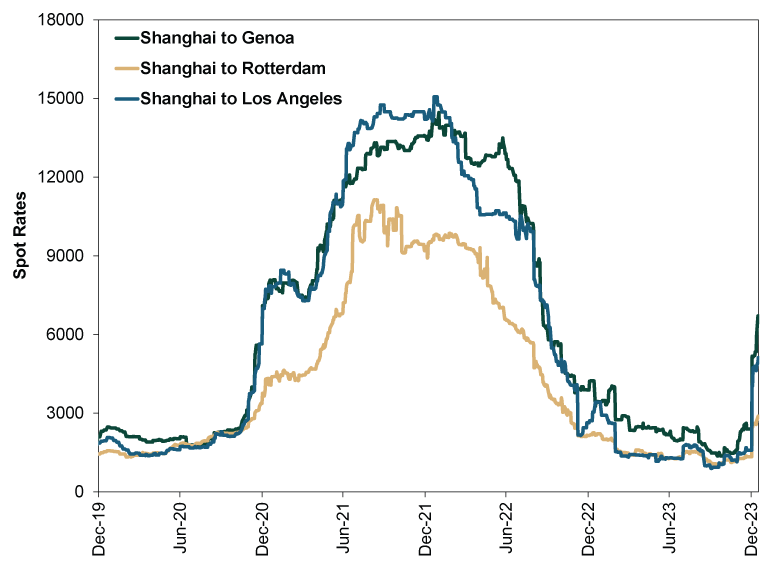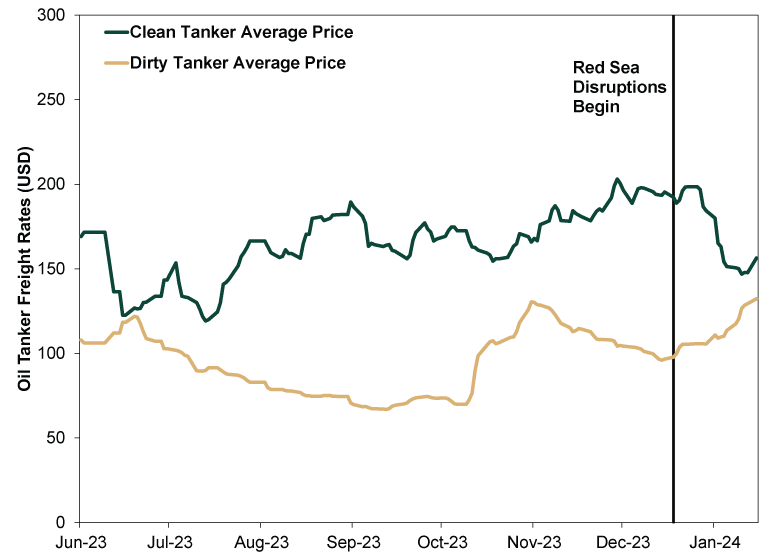Personal Wealth Management / Market Analysis
Rising Shipping Rates Are Likely Temporary
Freight costs are nowhere near 2021’s highs—for good reason.
Welp. The calendar may have flipped to 2024, but 2023’s fears haven’t gone away—including the attacks on oil tankers and cargo ships in the Red Sea. While trouble there may continue to stir short-term shipping rate and commodity price volatility, global trade has long proven its adaptability and resilience, suggesting rises would prove fleeting. Oil tanker freight rates may already reflect this.
Since we last checked in, trouble in the Red Sea has escalated. Houthi rebels have continued attacking Suez Canal-bound vessels despite the launch of Operation Prosperity Guardian—a US-led multinational maritime task force intended to protect commercial vessels traveling through the Red Sea.[i] On January 9, Houthis launched their 27th attack since November—their largest yet—firing 21 missiles and drones on US and UK warships.[ii] American and British forces successfully intercepted the attack, and on January 11, US and UK officials responded with airstrikes, reportedly killing five people. This set off fears of a wider conflict.[iii]
Given the increased violence, nearly 20 shipping carriers have announced diversion programs and over 300 containerships—80% of all Suez-bound containerships—have redirected around South Africa’s Cape of Good Hope, a 30% – 50% longer trip.[iv] This has prompted some companies to pause production or warn of shipping delays and higher costs, renewing fears of global supply chain disruptions and inflation.[v]
As a result, ocean freight spot rates for shipping goods from Asia to Europe and Asia to North America rose over 170% and 50%, respectively, while shipping volumes fell nearly -30% from pre-attack levels.[vi]
Exhibit 1: Spot Rates for Ocean Freight From Asia to Europe and the US

Source: DataStream, as of 1/16/2024. Daily shipping route prices, in USD, 12/31/2022 – 1/16/2024.
Hence, marine shipping stocks have outperformed both the MSCI World Industrials and the MSCI World over the last year—especially the past few weeks.
Exhibit 2: Isolating the Stock Market Impact

Source: FactSet, as of 1/16/2024. MSCI World Index, MSCI World Marine Transportation Index and MSCI World Industrials Index returns with net dividends, 1/13/2023 – 1/12/2024. Indexed to 100 at 1/13/2023.
However, despite headlines’ focus on spot rates’ recent rise, rates remain far below 2021 levels, when companies dealt with severe COVID reopening obstacles. (Exhibit 3)
Exhibit 3: A Longer Look at Spot Rates

Source: DataStream, as of 1/16/2024. Daily shipping route prices, in USD, 12/31/2019 – 1/16/2024.
In the pandemic’s early days, lockdowns hit consumption and barred production. But when restrictions lifted in the US and Europe, it spurred a wave of pent-up demand before businesses could ramp back up, causing mismatches galore. Carriers raised prices to offset elevated input costs—including fuel, containers and labor—causing freight rates to skyrocket. However, supply chain pressures eventually eased—taming freight rates—as demand relaxed and businesses made necessary adjustments (e.g., hired more, streamlined product offerings, got through order backlogs, etc.).
Presently, we see few similarities between 2021 and now. For one, there is no huge demand surge today like there was in 2021, and factories and ports globally are open for business. Two, the Suez Canal accounts for just 12% of global trade, whereas trade globally faced myriad headwinds three years ago as lockdowns lifted, making supply chain issues widespread.[vii]
However, what is similar between 2021 and now is companies’ ability to adapt. This likely helps the jump in freight rates reverse, much as they did in 2022 – 2023. Just as companies hustled to hire more to respond to increased demand then, shipping companies are sending tankers via alternate routes to ensure goods and commodities reach their intended destinations with as little delay as possible now.
Plus, rerouting Suez-bound freight via the Cape of Good Hope isn’t exactly unusual. A weather-induced blockage caused the Suez Canal to close completely for six days in 2021.[viii] Yet, freight rates barely reacted, most likely because ships re-routed around Africa—just as they are now. Sure, the closure caused some delays, just as the current situation is doing. However, as long as ships can pass through the Cape of Good Hope, delays likely remain limited, especially since 20% of containerships are still pursuing travel through the Suez Canal.
Oil tanker freight prices may be starting to reflect this. In 2023’s first half, 9 million barrels of oil per day passed through the Suez Canal.[ix] 15% of goods imported into Europe, the Middle East and North Africa were shipped from Asia and the Gulf via the Red Sea, 13% of which was crude oil. Yet oil tanker freight rates have already started falling.[x] (Exhibit 4) This may suggest investors are starting to appreciate global trade is adaptable.
Exhibit 4: Oil Tanker Freight Rates

Source: Refinitiv, as of 1/16/2024. A dirty tanker is an oil tanker used to transport crude oil or other “black oils,” like residual fuel oil, whereas a clean product tanker transports finished refined products, such as gasoline or diesel.
It is normal for sudden developments in maritime trade to cause volatility in shipping rates as market participants grapple with the surprise and make adjustments. It isn’t unlike how sentiment can jostle stocks, commodities and interest rates temporarily. But prices are signals for the industry to adjust, and it is doing so now—which should help reality exceed dim expectations.
[i] “Statement From Secretary of Defense Lloyd J. Austin III on Ensuring Freedom of Navigation in the Red Sea,” U.S. Department of Defense, 12/18/2023.
[ii] “Who Are the Houthis and Why Did the US and UK Retaliate for Their Attacks on Ships in the Red Sea?,” Tara Copp, ABCNews, 1/11/2024.
[iii] “U.S. and Britain Launch Strikes Against Houthi Rebel Targets in Yemen,” Courtney Kube and Tim Stelloh, NBC News, 1/12/2024.
[iv] “80% of All Container Ships on Suez Route Divert to Cape of Good Hope,” Antonis Karamalegos, Container News, 1/9/2024.
[v] “Tesla Pauses Production at German Factory as Red Sea Attacks Disrupt Supply Chains,” Staff, The Associated Press, 1/12/2024. “Ikea Says Products Will Be Delayed Due to Red Sea Diversions,” Jenni Reid, CNBC, 12/21/2023.
[vi] “Spot Container Shipping Rates Soar 173% on Red Sea Threats,” Brendan Murray, Bloomberg, 1/4/2024.
[vii] “Fears of Higher Oil Prices After Red Sea Attacks,” Nick Edser, BBC, 12/19/2023.
[viii] “Suez Canal Mishap Puts Battered Supply Chains Under More Pressure,” David J. Lynch, The Washington Post, 3/27/2021.
[ix] “What Do Red Sea Assaults Mean for Global Trade?,” Michael Race, BBC, 1/12/2024.
[x] Ibid.
If you would like to contact the editors responsible for this article, please message MarketMinder directly.
*The content contained in this article represents only the opinions and viewpoints of the Fisher Investments editorial staff.
Get a weekly roundup of our market insights
Sign up for our weekly e-mail newsletter.

You Imagine Your Future. We Help You Get There.
Are you ready to start your journey to a better financial future?

Where Might the Market Go Next?
Confidently tackle the market’s ups and downs with independent research and analysis that tells you where we think stocks are headed—and why.





